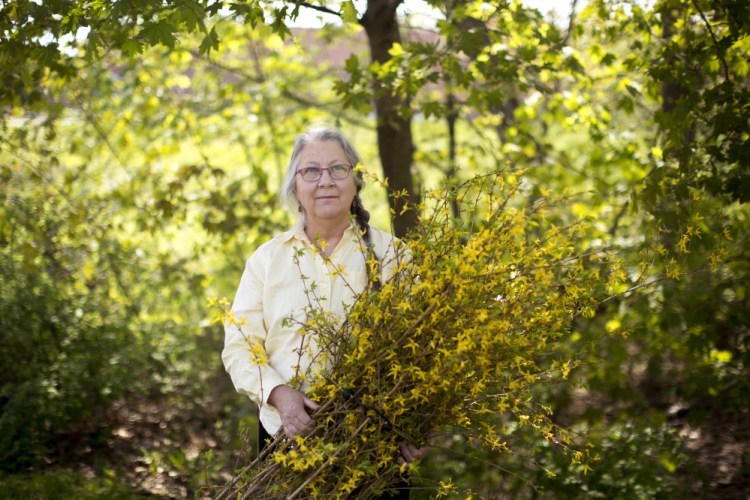On Thursday, Woolwich artist Susan Perrine spent the day building a woven twig garden structure with students at Lyseth Elementary and Lyman Moore schools in Portland. The project is funded by L.L. Bean through its Outdoor Discovery, Adventure and Stewardship Grant program. We called Perrine up to talk about the environmental lessons she hopes to convey. We learned about the role cute sheep played in the first time she made one of these huts, the ultimate handmade coat for going out for coffee and that time bohemian chic women’s retailer Anthropologie came calling.
WEAVING WITH WOOD: Perrine relocated to Maine from Rhode Island in 2001. She’d long been a volunteer at schools in the Ocean State, doing weaving demonstrations, including in a Sheep-to-Shawl program with a couple of friends. That couple brought the sheep, trotting them up and down stairs and into classrooms, and did the spinning. That was the flashy part of the demonstration. Perrine brought a loom. “And the kids weren’t interested at all.” In 1998 she decided to shake it up and present weaving to the children in a different, more hands-on way, putting bamboo stakes in the ground and having the children weave twigs in between. Soon thereafter Perrine started a job at an art museum and at its bookstore, discovered the work of Andy Goldsworthy, a sculptor who works entirely with natural materials, creating pieces that are often ephemeral, captured only in photographs. She swooned.
MAINE MOVE: The same year she moved to Maine, another sculptor known for his “stick work,” Patrick Dougherty, built “Simple Pleasures,” a cluster of huts on the Bowdoin College campus. Friends kept telling Perrine she needed to go see it. “Finally, I went there. It had snowed and they were like ice cream cones. And it was snowing and the snow was like snow globe snow, falling so softly. I was like, ‘Oh my God, I was really meant to be in Maine.’ ”
IN THE STICKS: She freely admits to some envy of Dougherty, who works with assistants. During her time in Maine, Perrine has built twig installations for exhibit (inside) at the University of Southern Maine campus in Lewiston and at a number of schools. Typically, she builds them in a day and maybe they don’t look quite as spectacular as the Dougherty pieces. “I want them all to be beautiful, but they are hand-built and you just can’t control it.” When she was working on a twig structure at the Coastal Maine Botanical Gardens in Boothbay, one of the staffers there helped her move twigs with a “beautiful red” dump truck. “I never had this much help before. I wondered whether Patrick Dougherty has a big truck like that!”
LESSON LEARNED: After she built a twig house at Troy Howard Middle School in Belfast, she returned that September and found that the students, who had an active gardening program, had planted climbing squash and vines around it. The hut was covered in green and she said sitting inside it “just blew my mind. … There were vines like, lounging on the twigs. It was transformative. It was like I was inside a green womb there.”
CUTTING WITH CARE: That was about 10 years ago, she said. Perrine has made a habit of bringing seeds with her when she works on an installation, a kharmic way of making up for any disruption she’s caused by cutting twigs. But generally speaking, “I try to cut where there is a lot of competition,” or better yet, in an area that is planned for wood harvesting anyway. She favors birch, maple or oak and cuts segments between 5 and 15 feet long. “I am looking for long, flexible twigs.” At Lyseth, she was working on a conical structure and had some help from students in PATHS (Portland Arts and Technology School), who built the basic structure and framework for a thatch roof, using saplings that had been cut to make room for a solar collecting station. She has plans to oversee another school installation, scheduled for June at an elementary school in Freeport.
COFFEE KLATSCH: In the meantime, she’ll be showing off another creation at Damariscotta’s Stable Gallery, a coat made with something much less recyclable than wood: old coffee bags. “The plastic-coated things.” She gathered bags from Starbucks and local coffee roasters like Wicked Joe’s. “Which is material I just can’t bear to throw away.”
SURPRISE SALE: Most of her installations don’t stay up long, even when they’re outside. Perrine didn’t know what to do with the piece she’d shown at USM (it was a little big for her living room) so she put it up for sale on Etsy. “I said I would deliver anywhere within 50 miles.” She was not imagining that a buyer from Anthropologie would get in touch. “It was a total fluke.” The buyer asked Perrine to make two new sculptures, which were photographed and made it into the chain’s catalog and sold for “just under $2,000” each. No repeat sales however. “The shipping alone must have been so expensive.”
MESSAGE IN THE METHOD: But being sold in a high-end retail store is not her aim. She’d rather work with kids. “I want them to get their hands on natural materials. I want them to know that they could just go in their backyard and make a small thing for themselves.” The best part about her work with twig art is where the “studio” is. “I like to be outdoors. And this gets kids out in the woods.”
Mary Pols can be contacted at 791-6456 or at:
Twitter: MaryPols
Send questions/comments to the editors.




Comments are no longer available on this story